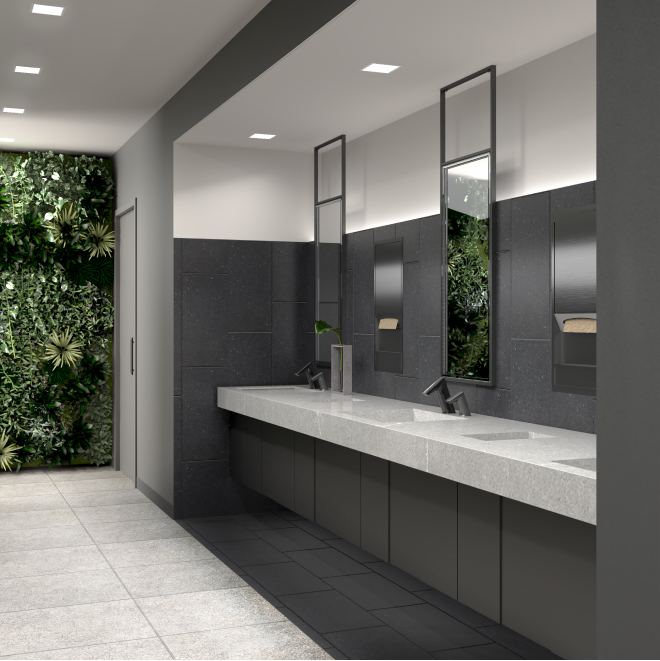Sign Up for “Exploring the WELL Building Standard and the Plumbing Industry’s Role in Health and Wellness.”
If you’re a commercial architect, designer, or engineer one of your highest priorities is creating spaces where people feel safe and comfortable. Yet recent research has revealed that nearly three quarters of North Americans don’t consider the air and water in office, condominiums, and hotel buildings to be safe.
How can you reverse that trend? What steps can you take to design commercial facilities in which people feel safe?
The WELL Building Standard was created to help answer those questions. Now, you can learn how to apply that standard to your future restroom designs—and earn the continuing education (CEU) credits you need at the same time.
“Exploring the WELL Building Standard” Offers CEU Credits—and Vital Insights
Our new course, “Exploring the WELL Building Standard and the Plumbing Industry’s Role in Health and Wellness,” lets you earn CEU credits for AIA, IDCEC, GBCI, ASPE, and several other programs. What you learn will help you:
-
Understand the need for healthy buildings, the importance of the WELL Building Standard, and the International WELL Building Institute.
-
Introduce the 10-Concept WELL Certification framework.
-
Explore how commercial restroom products can help designers achieve WELL Certification.
-
Identify how reducing water consumption in commercial restrooms impacts the health and well-being of building occupants and technologies that have been developed to overcome perceived challenges.
The insights you gain from this course will help you better design projects that meet the WELL Building Standard, so you can reassure property owners and managers that occupants will enjoy healthy conditions inside those buildings.
What is the WELL Building Standard?
The International Well Building Institute (IWBI) launched WELL v1.0 in 2014. Since then, IWBI has iterated the standard and recently launched WELL Version 2 (WELL v2™), which offers “a vehicle for buildings and organizations to deliver more thoughtful and intentional spaces that enhance human health and well-being.”
The standard is based on 10 concepts:
-
Air
-
Water
-
Nourishment
-
Light
-
Thermal comfort
-
Materials
-
Movement
-
Sound
-
Mind
-
Community
This CEU course primarily focuses on the second concept—water—since this is where commercial restroom design has the most direct impact. Parts of the course touch on other areas as well, since many of these concepts overlap and build on each other.
The WELL Water Concept
The WELL Water Concept is a method for monitoring the quality, distribution, and control of water in a building. The concept addresses the availability and contaminant thresholds of drinking water, as well as water management practices that avoid damage to building materials and environmental conditions.
For commercial restroom design, the most relevant ideas within the WELL Water Concept apply to handwashing and hygiene:
-
Sensor-activated faucets, soap dispensers, and hand dryers that promote better hygiene by reducing the surfaces users touch when they use the restroom
-
Hands-free flushometers that allow touch-free use while distinguishing between passersby and actual users to minimize accidental flushes
-
Line-purge technology for faucets and flushometers that reduces the serious water safety risks associated with prolonged system inactivity (especially important as workers return to offices in the wake of COVID-19)
-
Non-potable water use indication that lets facilities use reclaimed water for flushing while avoiding the risk of occupants consuming it
This course offers an understanding on how the restroom products you specify can help a building meet the WELL Building Standard—and help make facilities healthier for everyone who occupies them.
Sign up today for Exploring the WELL Building Standard and the Plumbing Industry’s Role in Health and Wellness.
Sloan’s Accredited CEU Courses
Sloan is uniquely qualified to help you meet accreditation requirements and stay on top of the latest news in commercial bathroom design. Thousands of people have taken our online courses, and we’ve conducted hundreds of “lunch & learn” events.
We’re happy to help you upgrade your knowledge. Explore our many CEU course offerings. Have questions? Contact us for more information.
Stay Up to Date
Sign up for the Sloan blog to receive information on the latest trends in commercial building, technology advancements and product updates. It's the leading source of industry news for architects, designers, engineers and contractors.
